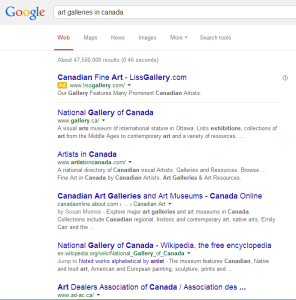Submitted by: Sydney Luther, Communications Assistant, and Vivian Orr, Communications and Publications Coordinator
In order to have your work exhibited in a gallery, you need to approach a gallery. However, like many things in life, some ways are more effective than others. Often gallery owners and directors become frustrated with the lack of understanding from artists about what they do and how they do it. We asked several gallery owners and operators what they wish artists knew before applying to a gallery. This is what they told us.
 |
| With the internet, it’s very easy to do your research about any gallery. |
First and foremost: do your research. Before contacting a gallery, check out their website and mission statement. What kind of work does the gallery show? What level of artists do they exhibit? Do you need to be a member of an organization to show there? Is your artwork a fitting style for that gallery? As one gallery owner wrote, “An abstract artist contacting a traditional gallery will probably not get a response.” Be realistic about the gallery and your work. Another owner advised, “If you are a new artist with no gallery experience, approaching a major art institution is likely not going to be fruitful.”
The second most common comment is do not walk into a gallery with your work hoping to find someone who will be immediately available to talk to you about showing or selling your pieces in their gallery. Find out who the most appropriate staff member is to speak to, and make an appointment. Everyone’s time is important; show that you value and respect theirs as much as your own. If you do walk into a gallery without an appointment, do not expect instant feedback about your work. Most galleries will not accept walk-ins of this kind.
The next advice given by those we interviewed is to check the submission protocol of the gallery. Submit everything the gallery asks for, which may include an artist’s statement, a curatorial statement, a CV, an estimate of value, and photographs in the correct type of file (for example, .jpg or .gif files). Follow the instructions you are given regarding these types of procedures.
Do not simply cold call the gallery without first doing your research. In a book directed at new gallery owners, How to Start and Run a Commercial Art Gallery, Edward Winkleman writes:
Because cold-call submissions are often the least productive means of finding suitable artists, they tend to be most dealers’ least preferred means of searching. No matter how explicit your submission guidelines may be about the type of art you’re interested in, you are likely to receive package or e-mails with images of work that seems plainly wrong for your program. On the other hand, every now and then, an unsolicited submission will make your day. Either the artist has done his research and knows his work is a good match for your mission, or fate basically smiles on you. (190)
Why not try your hardest to be that artist who makes a gallery owner’s day? Don’t wait for fate. Do your research!
One gallery manager pointed out that it is frustrating when artists are unrealistic about the costs of running a gallery. There are a huge number of expenses which are covered by the gallery’s commission on any artwork sold. A gallery’s share of a sale goes towards rent, utilities, advertising, staff, shipping, insurance, and security. This is why a gallery will take a percentage of the profit from any sales made.
The bottom line is to research the gallery before you apply. It will save everyone involved time and frustration. However, if you find that your first few applications are not fruitful, try to remember that there is a learning curve involved. A rejection could be an opportunity for constructive feedback and success in the future.
Winkleman, Edward. “Artists: Where To Find Them; How To Keep Them.” How to Start and Run a Commerical Art Gallery. New York: Allworth, 2009. 160. Print.
